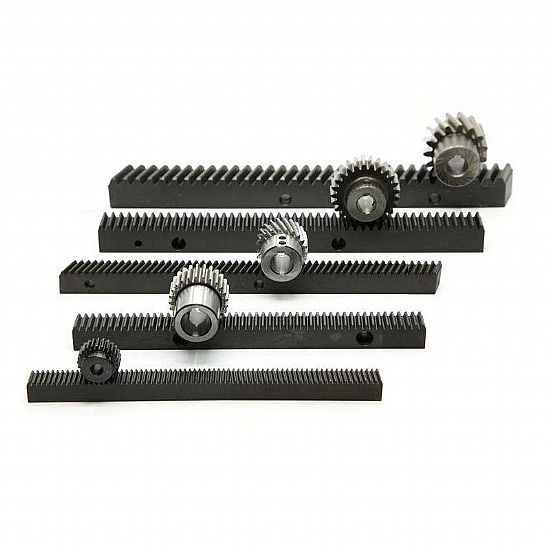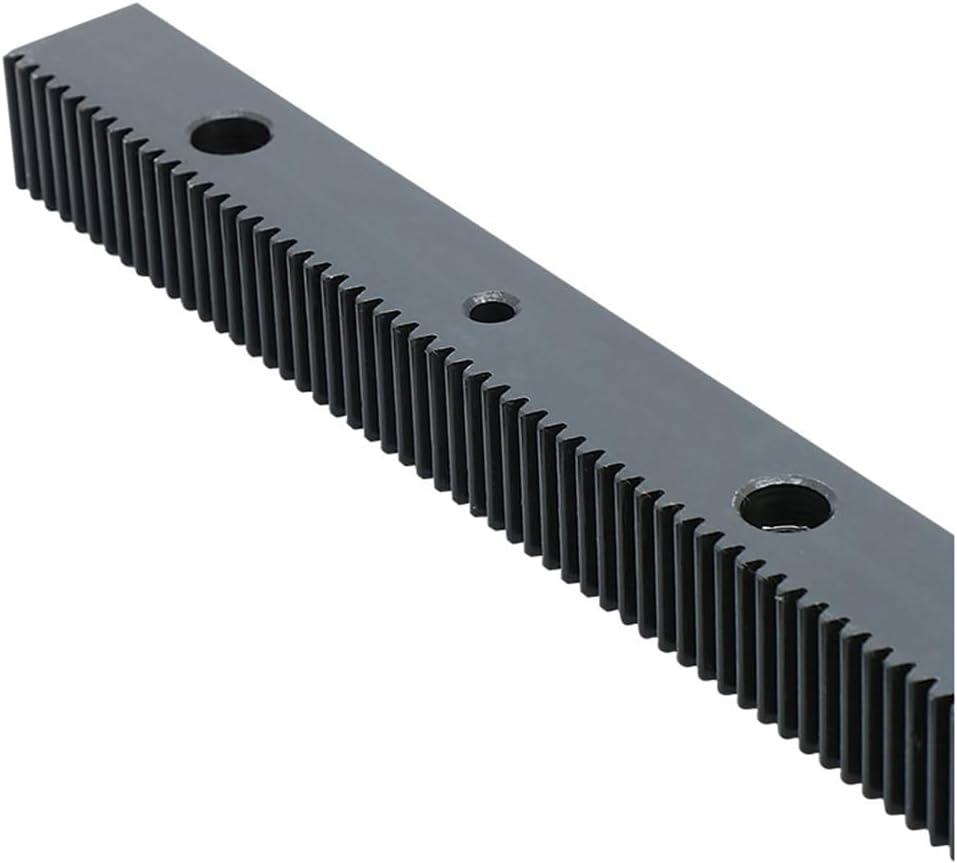Product Description
laser cutting machine gear rack
laser marking machine gear rack
grinding teeth gear rack DIN 6~7 class high precision gear rack
C45 material hardened teeth gear rack
CNC rack and pinion gears high quality cheap custom size
| Model number | M1-M12 |
| Material | Brass, C45 steel,Stainless steel,Copper,POM,Aluminum,Alloy and so on |
| Surface treatment | Zinc plated, Nickel plated, Passivation, Oxidation, Anodization, Geomet, Dacromet, Black Oxide, Phosphatizing, Powder Coating and Electrophoresis, etc |
| Standard | ISO, DIN, ANSI, JIS, BS and Non-standard. |
| Precision | DIN6,DIN7,DIN8,DIN9. |
| Teeth treatment | Hardened,Milled or Ground |
| Tolerance | 0.001mm-0.01mm-0.1mm |
| Finish | shot/sand blast, heat treatment, annealing, tempering, polishing, anodizing, zinc-plated |
Products show
Workshop
Measurement for teeth
Packing show
FAQ
Q1. What is your terms of packing?
A: Generally, we pack our goods in single color box. If you have special request about packing, pls negotiate with us in advance, we can pack the goods as your request.
Q2. What is your terms of payment?
A: T/T 30% as deposit, and 70% before delivery. We’ll show you the photos of the products and packages
before you pay the balance. Other payments terms, pls negotiate with us in advance, we can discuss.
Q3. What is your terms of delivery?
A: EXW, FOB, CFR, CIF.
Q4. How about your delivery time?
A: Generally, it will take 25 to 30 days after receiving your advance payment. The specific delivery time depends
on the items and the quantity of your order.
Q5. Can you produce according to the samples?
A: Yes, we can produce by your samples or technical drawings. We can build the molds and fixtures.
Q6. What is your sample policy?
A: We can supply the sample if we have ready parts in stock, but the customers have to pay the sample cost and
the courier cost.We welcome sample order.
Q7. Do you test all your goods before delivery?
A: Yes, we have 100% test before delivery
Q8: How do you make our business long-term and good relationship?
1. We keep good quality and competitive price to ensure our customers benefit ;
2. We respect every customer as our friend and we sincerely do business and make friends with them,
| Application: | Motor, Electric Cars, Motorcycle, Machinery, Marine, Toy, Agricultural Machinery, Car |
|---|---|
| Hardness: | Hardened Tooth Surface |
| Gear Position: | Internal Gear |
| Manufacturing Method: | Cut Gear |
| Toothed Portion Shape: | Double Helical Gear |
| Material: | Stainless Steel |
| Samples: |
US$ 2/Piece
1 Piece(Min.Order) | |
|---|
| Customization: |
Available
| Customized Request |
|---|

Can helical gear racks withstand variations in environmental conditions?
Helical gear racks are designed to withstand variations in environmental conditions to a certain extent. However, the ability of a helical gear rack to tolerate and perform well in different environmental conditions depends on several factors, including the choice of materials, surface treatments, lubrication, and proper maintenance. Here’s a detailed explanation:
- Choice of Materials: The materials used for helical gear racks play a crucial role in determining their resistance to environmental conditions. Materials such as stainless steel, corrosion-resistant alloys, or specially coated surfaces can enhance the gear rack’s ability to withstand exposure to moisture, chemicals, and temperature variations. It’s important to select materials that have the necessary corrosion resistance, strength, and durability to withstand the specific environmental conditions in which the gear rack will operate.
- Surface Treatments: Surface treatments, such as coatings or plating, can provide additional protection to helical gear racks against environmental elements. For example, applying a corrosion-resistant coating or a protective layer can help prevent rust or degradation of the gear rack’s surface when exposed to moisture or corrosive substances. Surface treatments can also improve the gear rack’s wear resistance, reducing the impact of abrasive particles or contaminants in the environment.
- Lubrication: Proper lubrication is essential for the smooth operation and longevity of helical gear racks, especially in challenging environmental conditions. Lubricants help reduce friction, wear, and heat generation between the gear teeth, promoting efficient power transmission and minimizing the risk of damage. In environments with high humidity, extreme temperatures, or heavy contamination, special lubricants with enhanced properties, such as increased resistance to water washout or extreme temperatures, may be required.
- Maintenance: Regular maintenance is crucial to ensuring the optimal performance and longevity of helical gear racks, particularly in varying environmental conditions. Maintenance practices may include periodic inspection, cleaning, lubrication replenishment, and replacement of worn or damaged components. By following recommended maintenance procedures, any issues or potential failures can be identified and addressed promptly, reducing the risk of environmental conditions affecting the gear rack’s performance.
While helical gear racks can withstand variations in environmental conditions to a certain extent, there are limits to their tolerance. Extreme environmental conditions, such as highly corrosive environments, extreme temperatures beyond the material’s limits, or severe contamination, can significantly impact the gear rack’s performance and longevity. In such cases, additional measures, such as using specialized materials, employing protective enclosures or seals, or implementing environmental controls, may be necessary to ensure reliable gear rack operation.
It’s important to consider the specific environmental conditions in which the helical gear rack will be used and consult with gear rack manufacturers or specialists to determine the most suitable design, materials, and maintenance practices to withstand those conditions. By selecting appropriate materials, implementing protective measures, and adhering to proper maintenance procedures, helical gear racks can maintain their performance and durability even in challenging environmental conditions.

How do helical gear racks handle variations in backlash and precision?
Helical gear racks are designed to handle variations in backlash and precision to ensure accurate and reliable motion control. Here’s a detailed explanation:
- Backlash Reduction: Backlash refers to the clearance or lost motion between the gear teeth when changing direction. Helical gear racks are known for their ability to minimize backlash compared to other gear types, such as spur gear racks. The inclined teeth of helical gear racks engage gradually with the mating gear, resulting in a smoother and tighter meshing. This gradual engagement helps reduce the effects of backlash, leading to improved precision in motion control systems. Additionally, proper gear design, manufacturing tolerances, and adjustments can further minimize backlash and optimize the performance of helical gear racks.
- Preload Mechanisms: To further enhance precision and reduce backlash, helical gear racks can be combined with preload mechanisms. Preload mechanisms apply a controlled amount of force or tension to the gear engagement, effectively eliminating or reducing any clearance or backlash between the gear teeth. This approach helps maintain a constant contact between the rack and the mating gear, resulting in improved precision and repeatability. Preload mechanisms can include springs, adjustable shims, or other devices that provide the desired level of force to counteract any potential backlash.
- High-Quality Manufacturing: Precision and accuracy in helical gear racks are greatly influenced by the quality of manufacturing. High-quality manufacturing processes ensure tight tolerances and proper tooth profiles, resulting in improved precision and reduced variations in backlash. Advanced machining techniques, such as CNC (Computer Numerical Control) machining, can be employed to achieve the required accuracy and consistency in gear rack production. Careful inspection and quality control measures during manufacturing help maintain the desired precision levels and minimize variations in backlash.
- Alignment and Assembly: Proper alignment and assembly of helical gear racks are crucial for handling variations in backlash and precision. Precise alignment ensures optimal meshing between the gear rack and mating gear, minimizing any misalignments or angular errors that could result in increased backlash. Proper assembly techniques, including torque control and the use of appropriate fasteners, contribute to maintaining the desired precision and reducing variations in gear engagement. Following manufacturer guidelines and best practices for gear rack installation ensures the optimal performance of the system and minimizes backlash-related issues.
- Regular Maintenance and Lubrication: Regular maintenance and proper lubrication are essential for maintaining the performance and precision of helical gear racks. Adequate lubrication reduces friction, wear, and variations in backlash by providing a protective film between the gear teeth. It helps ensure smooth and consistent motion, enhancing precision and reducing variations. Regular inspection, cleaning, and lubrication of the gear rack system are necessary to prevent any degradation in performance and to address any potential issues promptly.
By employing these approaches, helical gear racks can effectively handle variations in backlash and precision, enabling accurate and reliable motion control. Minimizing backlash, utilizing preload mechanisms, high-quality manufacturing, precise alignment and assembly, as well as regular maintenance and lubrication, contribute to achieving the desired precision and minimizing any variations that could affect the overall performance of the gear rack system.

What are the primary components and design features of a helical gear rack?
A helical gear rack consists of several primary components and design features that enable its functionality and performance. Here’s a detailed explanation of the primary components and design features of a helical gear rack:
1. Rack Body:
The rack body is the main component of a helical gear rack. It is a long, straight bar or rail that serves as the foundation for the gear teeth. The rack body is typically made of high-strength materials such as steel or alloy to withstand the forces and loads experienced during operation.
2. Teeth:
The teeth are the essential components of a helical gear rack. Unlike straight gear racks, the teeth of a helical gear rack are cut at an angle or helix to the rack’s axis. The helical teeth have a curved shape, resembling the teeth of a helical gear. The helical tooth design provides several advantages, including smoother operation, reduced noise, and improved load distribution.
3. Tooth Profile:
The tooth profile of a helical gear rack determines the shape and dimensions of the teeth. It is carefully designed to ensure proper engagement and meshing with the mating gear. The tooth profile includes parameters such as the tooth height, tooth thickness, tooth angle, and pitch. The tooth profile is crucial for achieving accurate and reliable motion transmission between the rack and the mating gear.
4. Pitch:
The pitch of a helical gear rack refers to the distance between corresponding points on adjacent teeth, measured along the pitch line. It determines the linear travel distance of the rack per revolution of the mating gear. The pitch of a helical gear rack is crucial for achieving precise linear motion control and synchronization with the mating gear.
5. Helix Angle:
The helix angle is the angle at which the teeth of a helical gear rack are cut relative to the rack’s axis. It determines the direction and inclination of the teeth. The helix angle is typically specified in degrees and affects the smoothness of operation, load distribution, and axial thrust forces generated by the gear rack.
6. Mating Gear:
The helical gear rack is designed to engage with a mating gear to transmit motion. The mating gear is typically a helical gear that meshes with the teeth of the rack. The design and specifications of the mating gear must be compatible with the helical gear rack to ensure proper meshing, efficient power transmission, and reliable motion control.
7. Mounting and Support:
The helical gear rack requires appropriate mounting and support to ensure stability and proper alignment. Mounting brackets or fixtures are used to secure the rack to the machine or system framework. The support structure should be rigid and capable of withstanding the forces and loads exerted on the gear rack during operation.
In summary, the primary components and design features of a helical gear rack include the rack body, helical teeth, tooth profile, pitch, helix angle, mating gear, and mounting/support structure. These components and features work together to provide smoother operation, reduced noise, improved load distribution, and precise linear motion control in applications where a helical gear rack is employed.


editor by CX 2023-10-17